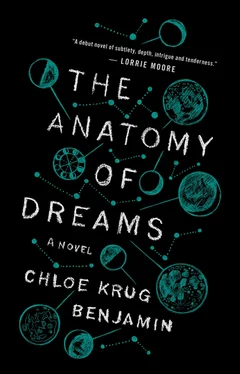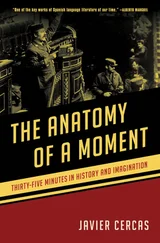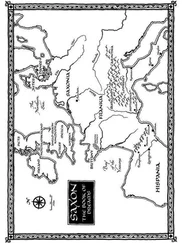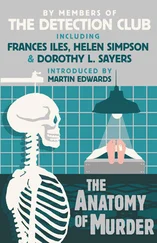In one brutal movement, I ripped my hands from the fence and leapt to the other side of the tracks. The first car barreled past me, and the force of its trajectory knocked me to my knees. I crouched in the pebbled dirt—candy wrappers and soda cans, beer bottles rolling in the wind—as the other cars came into view.
I had pictured the majestic ferocity of old freight trains, the coal-black engine and husk of white steam. But this train was ramshackle and tired, with a child’s crude design: blunt wheels, wagons in sallow shades of orange and yellow and brown. The sides were sprayed with graffiti. The train itself seemed to howl in protest, condemned to carry these stories, for how to clean a train—a pressure washer, a sandblaster?—and what would be the point, if the next night someone new came, spray paint in hand, to find the train’s canvas cleaned and ready?
I coughed dust as the last car passed. This was no brick-red caboose: those had been phased out in the 1980s and ’90s to cut costs, Gabe once told me—one of the random bits of knowledge I was no longer surprised he had. The manned caboose and its crew were deemed unnecessary, he said, the rails safe enough. The caboose conductor was replaced by an end-of-train device: a small electronic unit with a flashing red taillight.
But someone stood on the back of this car, his feet on the small aluminum platform, hands gripping the railing. He wore layers of dark clothes and studded boots, a knit cap pulled low; a heavy beard hung down to his shoulders. A train hopper. I had heard they rode in open boxcars or in the wells behind cargo containers. With night falling, the man blended into the charcoal-colored car and the dusky sky. Perhaps this had emboldened him, or maybe he just wanted air. Every few seconds, the flashing red light illuminated his swan-shaped cheekbones and the tube clutched in one hand—a map? A newspaper? I couldn’t tell.
As the engine pulled away, our eyes met, and sparks ran down my spine. He raised a hand in salute, and I did the same. Then the train sank into the darkness, swallowed like a stone in water, and just as unexpectedly as he had appeared, the man was gone.
18. MARTHA’S VINEYARD, MASSACHUSETTS, 2010
The Vineyard feels much more benign than it used to. It’s sunnier than it was in the summer of 2002, the product of a world hell-bent on heat. This year, seventy-degree days have been replaced by scorching stretches of drought, and the fertile plains of the Midwest are unable to bear food. The fog is a relief. Was it ever as foreboding, as secretive, as I once made it out to be? I’m eight years older now than I was that summer—in August, I’ll turn thirty—and my anxiety about the fog, its powers of concealment, has slipped away from me. It’s better that way, though I suppose the world has lost some of its glitter. It’s as though I’ve peeled away some holographic veneer, and the world is stark, actual. Night fits obediently into its little box. And I, perhaps, fit obediently into mine.
It’s been years since I dreamed the way I did in Madison. I don’t walk in my sleep anymore—two nightly medications and four years of careful calibration have seen to that. It’s strange; actually, the medications make my dreams easier to remember. I set up a video camera at the foot of the bed—an extreme measure, I know, which made me feel both protected and marginally insane—and each morning, I reeled through the previous night’s videotape. Aside from the occasional twitch, I was slack as a sack of flour. This calmed me, and soon I came to enjoy my dreams. Other people dropped into a state as blank and idle as a sleeping computer. But every night, I got to go to the movies—my one concession to the way I used to be.
Or maybe that’s just what I tell myself. There’s a crack in that floor, and I stay as far away from it as possible. The truth is that there will always be a fault line in me, and fault lines are never a single, clean fracture; when the surface of your world is displaced, the plates shuffled and broken like china, you can never step as carelessly as you used to. The medications keep me asleep, and trying to find some pleasure in my dreams keeps me from hating them—or the place in me they come from. How can I explain how it feels to be constantly on guard, afraid not of what someone else could do to you but of what you might do to yourself? It’s like owning a rottweiler: no matter how sweet she is at home, she’ll speak for herself once she’s off-leash in the dog park, and there’s not a thing you can do to control the way she tears through the grass, the way she howls like sin; you can only smile with embarrassed apology at the other owners and mutter thinly, “She thinks she’s a wolf.”
Once I got to the Vineyard, I couldn’t resist the urge to drive past the Snake Hollow compound, even though—or perhaps because—I knew it would look nothing like it used to. In the fall of 2008, a developer bought the compound, gutted the insides of the buildings, and began work on a two-year project that turned each one into a cluster of vacation condominiums. He kept the name—Snake Hollow, sure to attract couples in search of a storied, moody island escape—but to me it felt terribly wrong. I pulled smoothly into the driveway, which had been dug out and paved, and there they were: the three original structures, shingles painted the impeccable white of veneers.
Each building was roughly the same shape and size, but there were new appendages here and there: another porch, an extra wing. Each condominium had its own entrance, so that walkways jutted out of the building in various directions, crawling with guests. A family of five emerged from what was once the bunk room, clutching noodles and boogie boards and a giant yellow float in the shape of a slug; a child stood inside one of the windows of the old library, testing the air with her foot before being sucked into the room by an invisible parent. In front of the driveway, on a newly planted stretch of bright green grass, a young couple sat knock-kneed in sunglasses, sharing a peach. They looked at me with casual interest as I reversed out of the driveway.
On the side of the road, stalks of dune grass waved in salute or farewell. Twenty yards away was the beach, where a group of teenage boys stood with fishing poles. I slowed to watch them: their slender, eager bodies, the round whip of the lines. Every so often, a lone holler signaled a tug from the water. I still remember the night Keller returned to the compound from one of his afternoon walks with the gasping, sparkling body of a striped bass. Its jaw gaped, lips wide enough to hold a grapefruit. It wasn’t even bloody. Silver-green, round-bellied and pulsing, the fish was so robustly itself that it was hard to believe it would soon be split, skin slipped off like a dress, and reincarnated on Keller’s floral china plates, the meat buttered and fried to a crisp.
The sunset that night was startlingly neon—searing orange and highlighter pink as Keller paused in front of the French doors and the fish stilled. I wondered why it didn’t resist him. I’d heard about the power of striped bass. They weighed as much as sixty pounds; mature, they had few enemies. But the one in Keller’s hands was docile, resigned. Its eyes—even larger than a human’s, the black irises pits in pools of yellow—stared out at the room with what seemed like attention, as if Keller were offering not death but a privilege. Here, he seemed to say, was life on land.
19. MADISON, WISCONSIN, 2005
My mind wanted to forgive Gabe. But my body couldn’t. I kept expecting to return to bed with him, but as the days passed, the charge around that room only gathered strength. I went upstairs to grab clothes or a book when he was out, and when I returned downstairs, I felt contaminated. Only one thing made me feel better: that Gabe didn’t know—or wasn’t sure about—what had happened at Thom’s. At the time, it was my only, meager stitch of power. That knowledge, knowledge of how far I had gone, was what Keller and Gabe most desperately wanted. It was what they had spent years fishing for, what they were betting their careers on. And in the terrible weeks that followed, weeks I spent in a hazy state of limbo, I guarded it with everything I had left.
Читать дальше












